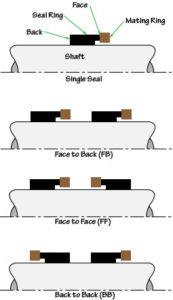The definitions for seal orientations have been tweaked a bit in order to make those definitions more general. At first glance, this revision might seem to make the SealFAQs definitions differ from the API 682 definitions however, there really is no conflict. Note that although SealFAQs includes much information about API 682, SealFAQs is much more general. To save you a click or two, the revised definitions read
Back-to-back = Dual seal in which both of the seal rings are mounted between the mating rings.
Face-to-face = Dual seal in which both of the mating rings are mounted between the seal rings.
Face-to-back = Dual seal in which one mating ring is mounted between the two seal rings and one seal ring is mounted between the two mating rings.

Although rotating springs are shown in the illustration above, the same definitions apply to seals having stationary springs or even to configurations mixing rotating and stationary springs.
The revised SealFAQs definitions now consider only the physical orientation of the seal rings and mating rings and not how the resulting configuration might be applied. This is a much more general approach than is used in API 682 but is not in conflict with API 682. In API 682:
The back-to-back configuration is used for Arrangement 3 and has the barrier fluid on the OD of both the inner and outer seals.
The face-to-face configuration is used for Arrangement 3 and has the barrier fluid on the OD of both the inner and outer seals.
The face-to-back configuration can be used for either Arrangement 2 or Arrangement 3 and has the barrier or buffer fluid on the ID of the inner seal and OD of the outer seal.
Outside of API 682, other schemes for pressurization and operation are sometimes used – although I must say that I don’t like some of them!
